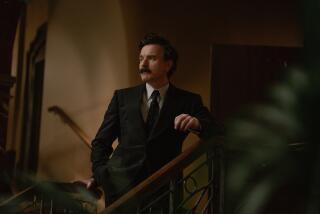Playing The Woman Behind The Tyrant
- Share via
“A lone black car with dark tinted windows made an eerie sound, like echoing thunder, as it rolled over cobblestones past solemn guarded gates. Just outside, the gigantic GUM store stood completely empty of wares for shoppers. And here we were, filming in the fairy world of the Kremlin, with its opulent buildings and extraordinarily beautiful churches, a closeted world within another world, out of touch.” These are some of the haunting images Julia Ormond recalls from the location shoots of “Stalin.”
Ormond plays Nadya, the ill-fated wife of the mercurial man many call tyrant and some still call hero. She liked the role as soon as she saw the script. “It’s a good piece for women,” Ormond says. “I like the love of freedom that’s instilled in her, her mother and her friend, Anya Larina Bukharin.”
Research for her role began at a Charing Cross Road bookstore near her London home. “There wasn’t a lot written about Nadya,” Ormond says. “Basically, the books say she married him and killed herself 12 years later.” The Stalins’ daughter, Svetlana, wrote a book called “Twenty Letters to a Friend,” recalling her happy childhood summers, and from this Ormond began to develop a feeling for her character.
Nadya was a romantic, idealistic revolutionary also when she met Stalin. “I think she fell in love with a hero figure and was excited about what she thought they’d go on to do,” Ormond says. “Coming to terms with the reality of what Stalin had become led to her nervous problems and suicide. He no longer listened to her; she became superfluous to him; there was nowhere to turn, so she committed suicide.
To Ormond, “Nadya represents how Stalin broke down the positivity of the Russian revolution, the end of the hope for the new order. ... It was extremely difficult for me to come to grips with the enormity of what Stalin had done, the mass murder and cruelty,” she says. Yet in speaking to some Russian extras and crew members, Ormond gained new perspective.
“For the world to go forward, we have to see and understand different ways of living. I would plead for tolerance and immense understanding for the psychological damage that Russia has to recover from. To recognize how they’ve suffered under this political system is to realize they’ve wasted their lives. And it must be so frustrating to the young to see the apathy, the need, the hunger.
“It was very strange, particularly filming the re-creation of Stalin’s funeral. They seemed upset they hadn’t been given furs and better clothing for the scene. They said that, ‘when he was alive we were strong and well-dressed.’ They wept at the scene. How much they have to let go of.”
Her perspective as an actress was also enhanced working with a stellar cast. “It was terribly exciting to be doing ‘Stalin’ with so many people I wanted to work with,” Ormond says. “Robert Duvall gives so much. He’s so very believable. Often he would save something for a take, rather than do it in rehearsal. These different setups allow other actors to really be surprised, which adds some edge to everyone’s performance.”
American audiences may not be familiar with this British beauty yet. So far she’s best known for her stage work in England. Ormond has been seen in the United States in the title role on the TV miniseries “Catherine the Great” and as a heroin addict in PBS’ “Traffik.”
She’d like to do more work in the United States, but continues her love for the theater. “You learn so much from the rehearsal time. In TV and film you have to make so many choices on your own, not that it’s impossible or bad, but there’s more opportunity to grow and develop with time.
“My goal is to establish myself as a good enough actor to keep working when I’m in my 40s and 50s,” Ormond says. “That seems to be the cutoff point for women; I’d like to bridge that gap. I want to direct also, to see it all from a different perspective. The director’s vision is that of an entire picture--a moving picture--that takes me back to my art school days; that background gives me a strong compositional strength.”
More to Read
Only good movies
Get the Indie Focus newsletter, Mark Olsen's weekly guide to the world of cinema.
You may occasionally receive promotional content from the Los Angeles Times.










